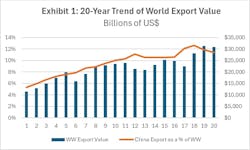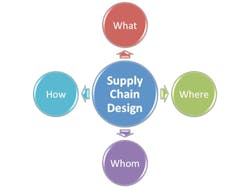Reshaping Global Supply Chains: Impacts of Tariff Hikes and Strategies for Resilience
As global supply chains continue to face challenges in 2024, a potential paradigm shift in U.S. trade policy looms on the horizon. The prospect of dramatically increased tariffs—up to 60% on Chinese imports and 10%-to-20% across all other trading partners, including Mexico—threatens to fundamentally reshape global supply chain landscape.
This dramatic shift in trade policy poses a particular challenge to companies that have recently invested in nearshoring and friendshoring strategies, forcing a comprehensive reevaluation of global supply chain designs.
Limitations of Current Approaches
Despite aggressive moves toward supply chain diversification in recent years, the global manufacturing ecosystem remains deeply interconnected. A case in point is the experience of a U.S. medical device manufacturer, whose story illustrates the complexities of supply chain redesign.
This company had been manufacturing in China for many years but faced cost pressures from 25% US tariffs on China-made goods since 2018 and customer demand to move production out of China.
In 2019, the company began nearshoring by relocating some production from China to Mexico. However, their hopes for cost savings on tariffs were dashed when they achieved only break-even results due to higher-than-anticipated labor costs and lower productivity in Mexico.
The COVID-19 pandemic further complicated matters, causing significant disruptions to their Mexico operations while their China plant maintained excellent supply chain performance. Despite avoiding the 25% US tariffs, the company found its supply chain still heavily reliant on China. After assessing the cost implications with customers, they had to put further relocation of manufacturing and supply chain on hold.
This case highlights a critical question for supply chain leaders: How can organizations build resilience against tariff risks while maintaining competitive cost structures?
Framework for Strategic Redesign
The answer lies in revisiting the fundamental principles of supply chain design by addressing four crucial questions:
- What materials, processes, or capabilities should be designed, developed, or manufactured in-house versus purchased from external suppliers?
- Where globally should you source capabilities or keep them internally?
- From whom should you source?
- How should you execute supplier management?
Thirty years ago, the approach to these questions was relatively straightforward: outsource non-core competencies, offshore to low-cost countries (often China), use total cost of ownership (TCO) to select suppliers and establish strategic partnerships as needed.
However, in the past decade, this direction began to reverse. Global supply chains were increasingly seen as sources of disruption and lack of resilience, leading to a focus on near-shoring and China-plus-one strategies, especially since the COVID-19 pandemic. Despite these shifts, global supply chains still rely heavily on China. World Bank data shows that China's manufacturing share of worldwide exports hasn’t shrunk much in the last five years.
Many corporations struggled to establish comparable alternative sources to China. According to our recent A 2024 Decision Guide to Global Sourcing, “across a board range of industries, China emerges as the most cost competitive nation.”
Companies relocated operations or switched to domestic or near-shore suppliers but found their cost structures significantly higher or struggled to find qualified suppliers. Now they are facing another disruption from the possible hike of US import tariff on all countries.
To achieve supply chain resilience while maintaining a competitive cost structure, we propose a framework for supply chain redesign based on the four fundamental questions.
What to produce vs. source?
During the peak of globalization, organizations benefited from outsourcing to keep fixed costs low and maintain a competitive overall cost structure. However, the line between core competencies to keep internally and non-essential functions to outsource became blurred. After experiencing numerous disruptions in recent years, organizations need to reassess their true core competencies.
This reassessment creates an opportunity to redesign global supply chains by insourcing critical capabilities and hard-to-control processes. This approach not only creates a competitive edge in the market but also enhances resilience through better supply chain control. Adopting the trade framework of country of origin, organization can determine their critical capabilities based on what the substantial transformations are.
By focusing on and insourcing critical capabilities, organizations can engineer the desired country of origin of their finished products for major markets, while strategically source less critical capabilities and processes to leverage external partners to keep material costs low.
Where to produce and source?
While producing and sourcing from low-cost countries keeps cost structures competitive, many organizations now take a more conservative approach to create more resilient supply chains. They aim to move production closer to home or major customers and keep suppliers nearby.
The intent is to shorten the supply chain and mitigate disruption risks. However, this approach typically only shortens the tier-one level at best, as supply chains remain globally interconnected. Even local or regional production doesn't necessarily offer lower risks than offshore production, as evidenced by recent disruptions such as the Baltimore bridge collapse, Microsoft system crashes or work stoppages at U.S. Gulf Coast ports, not to mention the possible change to USMCA and an immediate tariff increase.
Higher cost structures resulting from nearshoring or local production have contributed to an inflationary supply market in recent years. Many organizations implementing a China-plus-one strategy struggle to find comparable costs and reliable sources in other low-cost countries.
Companies should balance their desire to keep production close to customers with the need to access low-cost sourcing. While reducing dependence on China mitigates geopolitical risks, relocating production to home countries or other regions isn’t a straightforward answer when considering cost and supply chain performance.
India and Vietnam offer compelling value, particularly in labor-intensive industries with less complex supply chains, with overall FOB cost just 1% and 6% higher than China’s.
When establishing alternative sources to China, organizations should assess their bill of materials (BOM) to determine which commodities or value-creation processes drive the country of origin. Prioritize duplicating or transferring these elements to primary end market or other low-cost sources first by comparing the landed cost. This approach allows for more flexibility in selecting global production and sourcing locations while allowing more transition time out of China’s supply chain.
From whom to source?
After determining production and sourcing locations, supply chain leaders must focus on vetting specific suppliers. Selecting the right suppliers is the first line of defense in building supply chain resilience.
Many experienced sourcing professionals view India and Vietnam as being at a stage similar to China in the 2000s. Their logistics infrastructure and labor skills are still developing, and most materials need to be imported due to underdeveloped local supply chains.
Supply chain leaders must be willing to invest time and resources in developing suppliers in these countries. Implementing a robust supplier evaluation, selection and management program is crucial. Additionally, developing the skills of internal supply chain teams is critical to mitigating the risks associated with supply chain transitions.
Expect a slow learning curve for both your supply chain organization and new suppliers. Implementing a dual-sourcing strategy can mitigate risks initially, allowing you to maintain existing sources while gradually ramping up capabilities and capacity from domestic suppliers or suppliers in other low-cost countries. This approach also increases supply chain flexibility, enabling dynamic spend allocation to cope with global demand changes or geopolitical shifts.
How to manage sources?
Maintaining appropriate relationships with suppliers is key to successful supply chain redesign.
When organizations first began sourcing from China over two decades ago, many took a transactional approach, accepting things at face value. They sent drawings and specifications, and they accepted quotes at less than half the price paid to local suppliers. Initial celebrations of huge cost savings often turned sour when suppliers couldn’t deliver or when quotes proved inaccurate and prices had to be adjusted upward.
Organizations can apply these lessons learned from China to new suppliers in countries like Mexico or India. Success with suppliers from different cultures requires time and the right relationship-building approach.
Sourcing teams need to be more hands-on, creating internal alignment and building connections with suppliers across various functions, including quality, engineering and planning. Due diligence is necessary for both internal documentation accuracy and supplier proposals. Establish a collaborative problem-solving approach with selected suppliers to ensure long-term success.
Applying the Four-Step Framework: A Success Story
Revisiting our case study, the U.S. medical device manufacturer eventually took a different approach in redesigning its supply chain.
- What: They reassessed their core competencies and critical processes.
- Where: They scaled up the most critical manufacturing element in the U.S. from China and Mexico while exploring new sources for standardized commodities. This enabled U.S. country of origin for their finished products while keeping final assembly operation in China for EU and local markets.
- Whom: They qualified Vietnamese suppliers for standardized commodities. Not only did they reduce the supply chain spend with China, but also maintain the same level of material costs.
- How: They developed collaborative relationships with new suppliers and invested in training their internal teams.
This holistic approach allowed them to mitigate threats of higher U.S. tariffs on all imports, reduce exposure to the China supply chain while maintaining a similar BOM cost structure.
While headlines are often filled with eye-catching disruptions, supply chain leaders must remain focused on fundamental principles and apply critical thinking in designing global supply chains to meet customers' needs. This four-step framework of What, Where, Whom, and How provides a guide to designing a global supply chain that balances resilience with cost competitiveness.


